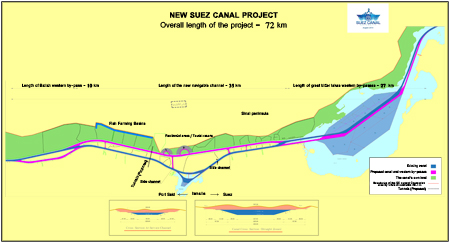The Suez Canal, a waterway running between Asia and Europe, was built between 1859 and 1869. It had a throughput of about 60 ships a day and duration of one crossing lasted approx. 22 hours. Unfortunately, the channel wasn?t wide enough to let the ship traffic go in both directions at the same time and the ships had to enter into special bays to let the other ones through.
After 145 years they decided to build a new canal next to the existing one. The official opening of the new canal of a length of 35 km is planned to take place on the 6th of August. The investment will enable ship traffic to go in both directions at the same time, reducing the time of cruise from 22 to 11 hours.
To finish the construction it was necessary to dig out 258 million cubic meters of sand which equates to a volume of 316 Palaces of Culture and Science in Warsaw. Near the Suez Canal the Egypt government plans to create an industrial and logistics zone.
NEW SUEZ CANAL
Holiday driving prohibition for trucks over 12 tonnes
Important reminder for the transport companies and clients awaiting cargo delivery.
Each year during the summer drivers of vehicles of over 12 tons have to abide by the road traffic restrictions.
According to the Regulation by the Minister of Transport, Construction and Maritime Economy of 16 May 2012, amending the regulation on periodic traffic restrictions and the prohibition of certain types of vehicles on roads (Legal Digest No. 147, item. 1040), the hourly ban on driving was imposed on trucks over 12 tons beginning on the last Friday of June until the last Sunday of August.
Railway or road transport ?
The ?Lorries on the tracks? slogan has recently become very popular and readers of this blog may find it often repeated in news bulletins also an argument in support for environmental protection. Unfortunately the matter is not so obvious and obvious as it might seem at a first glance. Below we shall point out advantages and disadvantages in brief.
